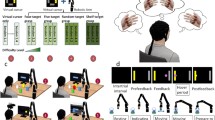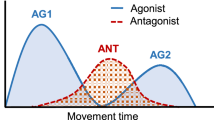Abstract
Functional Electrical Stimulation (FES) has demonstrated potential in clinical applications, but determining the optimal electrical current to stimulate muscles remains challenging due to the intricate coordination of various muscle groups during human movement. In this study, we introduce a novel approach to model and control human arm planar reaching movements. In terms of the model, a comprehensive human upper limb model is developed, taking into account the double-link structure, six muscles, and the connection points between muscles and the skeletal system. Regarding the control, a comprehensive sensorimotor control model emulating neural activities for human arm planar reaching movements is proposed. The control model effectively incorporates the imprecise nature of human visual sensory feedback for arm endpoint positioning and emulates the neural activities to determine appropriate stimulation levels for each of the six constituent muscles, inducing muscle contractions and guiding the skeletal systems to the target positions. The effectiveness of the proposed controller is demonstrated via numerical simulation experiments. Through comparisons with different controllers, it is shown that the proposed controller exhibits superior performance in tracking predefined motion trajectories and robustness in dealing with various skeletal muscle arm parameters.





















Similar content being viewed by others
References
Ory MG, Smith MR (2022) Editorial: Insights in Aging and Public Health: 2021. Frontiers in Public Health 10. https://doi.org/10.3389/fpubh.2022.929418
Graham W (2013) Neuro-geriatrics: A Clinical Manual Chapter 20: Tremor, Cham. https://doi.org/10.1007/978-3-319-56484-520
Marquez-Chin C, Popovic MR (2020) Functional electrical stimulation therapy for restoration of motor function after spinal cord injury and stroke: a review. Biomed Eng Online 19(1):1–25. https://doi.org/10.1186/s12938-020-00773-4
Vafadar AK, Côté JN, Archambault P (2015) Effectiveness of Functional Electrical Stimulation in Improving Clinical Outcomes in the Upper Arm following Stroke: A Systematic Review and Meta-Analysis. BioMed Res Int 2015:1–14. https://doi.org/10.1155/2015/729768
Oliveira AS, Gizzi L, Farina D, Kersting UG (2014) Motor modules of human locomotion: influence of EMG averaging, concatenation, and number of step cycles. Front Hum Neurosci 8. https://doi.org/10.3389/fnhum.2014.00335
Torres-Oviedo G, Ting LH (2007) Muscle Synergies Characterizing Human Postural Responses. J Neurophysiol 98(4):2144–2156. https://doi.org/10.1152/jn.01360.2006
Shirzadfar H (2021) The Structure and Function of Nervous System and Skeletal Muscle:A Review. Current neuropsychiatry and clinical neuroscience reports 3(1):1–25 https://doi.org/jneurosciences.com/index.php/cncnr/article/view/8
Parro C, Dixon M, Christoff K (2018) The neural basis of motivational influences on cognitive control. Hum Brain Mapp 39(12):5097–5111. https://doi.org/10.1002/hbm.24348
Liang H, Liu G, Zhang H, Huang T (2021) Neural-Network-Based Event-Triggered Adaptive Control of Nonaffine Nonlinear Multiagent Systems With Dynamic Uncertainties. IEEE transactions on neural networks and learning systems 32(5):2239–2250. https://doi.org/10.1109/tnnls.2020.3003950
Criss CR, Onate JA, Grooms DR (2020) Neural activity for hip-knee control in those with anterior cruciate ligament reconstruction: A task-based functional connectivity analysis. Neurosci Lett 730:134985. https://doi.org/10.1016/j.neulet.2020.134985
Svoboda K, Li N (2018) Neural mechanisms of movement planning: motor cortex and beyond. Current Opinion in Neurobiology 49:33–41. https://doi.org/10.1016/j.conb.2017.10.023
Hill AV (1938) The heat of shortening and the dynamic constants of muscle. Proceedings of the Royal Society of London 126(843):136–195. https://doi.org/10.1098/rspb.1938.0050
Romero F, Alonso F (2016) A comparison among different Hill-type contraction dynamics formulations for muscle force estimation. Mechanical Sciences 7(1):19–29. https://doi.org/10.5194/ms-7-19-2016
Wiedemann L, Jayaneththi V, Kimpton J, Chan HL-Y, Müller MA, Hogan A, Lim E, Wilson NC, McDaid A (2018) Neuromuscular characterisation in Cerebral Palsy using hybrid Hill-type models on isometric contractions. Comput Biol Med 103:269–276. https://doi.org/10.1016/j.compbiomed.2018.10.027
Rockenfeller R, Herold JL, Götz T (2020) Parameter estimation and experimental design for Hill-type muscles: Impulses from optimization-based modeling. Math Biosci 327:108432. https://doi.org/10.1016/j.mbs.2020.108432
Hussein M, Shebl S, Elnemr R, Elkaranshawy HA (2022) A New Muscle Activation Dynamics Model, That Simulates the Calcium Kinetics and Incorporates the Role of Store-Operated Calcium Entry Channels, to Enhance the Electromyography-Driven Hill-Type Models. J Biomech Eng 144(1). https://doi.org/10.1115/1.4051718
Schmitt S, Günther M, Häufle DFB (2019) The dynamics of the skeletal muscle: A systems biophysics perspective on muscle modeling with the focus on Hilltype muscle models. Gamm-mitteilungen 42(3). https://doi.org/10.1002/gamm.201900013
Xiuxiang C, Ting W, YongKun Z, Wen Q, Xinghua Z (2018) An adaptive fuzzy sliding mode control for angle tracking of human musculoskeletal arm model. Comput Elect Eng 72:214–223. https://doi.org/10.1016/j.compeleceng.2018.09.013
Wochner I, Driess D, Zimmermann H, Haeufle DFB, Toussaint M, Schmitt S (2020) Optimality Principles in Human Point-to-Manifold Reaching Accounting for Muscle Dynamics. Front Computat Neurosci 14. https://doi.org/10.3389/fncom.2020.00038
Xu D, Wu Q, Zhu Y-H (2021) Development of a sEMG-Based Joint Torque Estimation Strategy Using Hill-Type Muscle Model and Neural Network. Journal of Medical and Biological Engineering 41(1):34–44. https://doi.org/10.1007/s40846-020-00539-2
Wu Y, Chen J, Qiao H (2021) Anti-interference analysis of bio-inspired musculoskeletal robotic system. Neurocomputing 436:114–125. https://doi.org/10.1016/j.neucom.2021.01.054
Toshimitsu Y, Kawaharazuka K, Nishiura M, Koga Y, Omura Y, Asano Y, Okada K, Kawasaki K, Inaba M (2021) Biomimetic Operational Space Control for Musculoskeletal Humanoid Optimizing Across Muscle Activation and Joint Nullspace. International Conference on Robotics and Automation. https://doi.org/10.1109/icra48506.2021.9561919
Bernshteĭn NA (1969) The co-ordination and regulation of movements. Brain Res 13(3):624. https://doi.org/10.1016/0006-8993(69)90278-9
Morasso P 1981) Spatial control of arm movements. Experiment Brain Res 42(2). https://doi.org/10.1007/bf00236911
Takeda M, Sato T, Saito H, Iwasaki H, Nambu I, Wada Y (2019) Explanation of Fitts’w in Reaching Movement based on Human Arm Dynamics. Sci Report 9(1). https://doi.org/10.1038/s41598-019-56016-7
Ueyama, Y (2021) Costs of position, velocity, and force requirements in optimal control induce triphasic muscle activation during reaching movement. Sci Report 11(1). https://doi.org/10.1038/s41598-021-96084-2
Zhao Y, Zhang M, Wu H, He X, Todoh M (2023) Neuromechanics-Based Neural Feedback Controller for Planar Arm Reaching Movements. Bioengineering 10(4):436. https://doi.org/10.3390/bioengineering10040436
Rahatabad FN (2020) Modeling and Control Human Arm With FuzzyGenetic Muscle Model Based on Reinforcement Learning: The Muscle Activation Method. Int Clinical Neurosci J 7(3):138–146 https://doi.org/10.34172/icnj.2020.15
Fischer F, Bachinski M, Klar M, Fleig A, Müller J (2021) Reinforcement learning control of a biomechanical model of the upper extremity. Sci Report 11(1). https://doi.org/10.1038/s41598-021-93760-1
Gao Z, Xuan H-Z, Zhang H, Wan S, Choo K-KR (2019) Adaptive Fusion and Category-Level Dictionary Learning Model for Multiview Human Action Recognition. IEEE Int Things J 6(6):9280–9293. https://doi.org/10.1109/jiot.2019.2911669
He C, Xu X, Zheng X, Xiong C, Li Q-L, Chen W, Sun B (2021) Anthropomorphic Reaching Movement Generating Method for Human-Like Upper Limb Robot. IEEE Trans Cybern 52(12):13225–13236. https://doi.org/10.1109/tcyb.2021.3107341
Simoneau GG, Ulbrecht JS, Derr J, Cavanagh PR (1995) Role of somatosensory input in the control of human posture. Gait Posture 3(3):115–122. https://doi.org/10.1016/0966-6362(95)99061-o
Kakei S, Lee J-H, Mitoma H, Tanaka H, Manto M, Hampe CS (2019) Contribution of the Cerebellum to Predictive Motor Control and Its Evaluation in Ataxic Patients. Front Hum Neurosci 13. https://doi.org/10.3389/fnhum.2019.00216
Zhao Y, Zhang M, Ding S, Todoh M, Feng L (2022) Computational simulation for lifting motion of musculoskeletal arm. 2022 34th Chinese Control and Decision Conference (CCDC). https://doi.org/10.1109/ccdc55256.2022.10033644
Zhao Y, Ding S, Todoh M (2022) Validate the force-velocity relation of the Hill’s muscle model from a molecular perspective. Front Bioeng Biotechnol 10. https://doi.org/10.3389/fbioe.2022.1006571
Zhao Y, Li H, Wan S, Sekuboyina A, Hu X, Tetteh G, Piraud M, Menze BH (2019) Knowledge-Aided Convolutional Neural Network for Small Organ Segmentation. IEEE J Biomed Health Inf 23(4):1363–1373. https://doi.org/10.1109/jbhi.2019.2891526
Bohte SM, La Poutré H, Kok JN (2002) Unsupervised clustering with spiking neurons by sparse temporal coding and multilayer RBF networks. IEEE Trans Neural Netw 13(2):426–435. https://doi.org/10.1109/72.991428
Izhikevich EM (2003) Simple model of spiking neurons. IEEE Trans Neural Netw 14(6):1569–1572. https://doi.org/10.1109/tnn.2003.820440
Izhikevich EM (2006) Dynamical Systems in Neuroscience. https://doi.org/10.7551/mitpress/2526.003.0002 . https://doi.org/10.7551/mitpress/2526.001.0001
Spüler M, Nagel SN, Rosenstiel W (2015) A spiking neuronal model learning a motor control task by reinforcement learning and structural synaptic plasticity. International Joint Conference on Neural Network. https://doi.org/10.1109/ijcnn.2015.7280521
Kersen DEC, Tavoni G, Balasubramanian V (2022) Connectivity and dynamics in the olfactory bulb. PLOS Computational Biology 18(2):1009856. https://doi.org/10.1371/journal.pcbi.1009856
Izhikevich EM, Edelman GM (2008) Large-scale model of mammalian thalamocortical systems. Proceedings of the National Academy of Sciences of the United States of America 105(9):3593–3598. https://doi.org/10.1073/pnas.0712231105
Qu P, Yang L, Zheng W, Zhang Y (2022) A review of basic software for braininspired computing. CCF Transactions on High Performance Computing. https://doi.org/10.1007/s42514-022-00092-1
Arena P, Fortuna L, Frasca M, Patané L (2009) Learning Anticipation via Spiking Networks: Application to Navigation Control. IEEE Trans Neural Netw 20(2):202–216. https://doi.org/10.1109/tnn.2008.2005134
Oniz Y, Kaynak O (2014) Variable-structure-systems based approach for online learning of spiking neural networks and its experimental evaluation. J Franklin Instit-eng Appl Math 351(6):3269–3285. https://doi.org/10.1016/j.jfranklin.2014.03.002
Morrison A, Diesmann M, Gerstner W (2008) Phenomenological models of synaptic plasticity based on spike timing. Biological Cybernetics 98(6):459–478. https://doi.org/10.1007/s00422-008-0233-1
Tang G, Michmizos KP (2018) Gridbot: An autonomous robot controlled by a spiking neural network mimicking the brain’s navigational system. Proceedings of the International Conference on Neuromorphic Systems 1–8. https://doi.org/10.1145/3229884.3229888
Fernández J, Vargas M, García JA, Carrillo JD, Aguilar JA (2021) A biologicallike controller using improved spiking neural networks. Neurocomputing 463:237–250. https://doi.org/10.1016/j.neucom.2021.08.005
Author information
Authors and Affiliations
Corresponding author
Additional information
Publisher's Note
Springer Nature remains neutral with regard to jurisdictional claims in published maps and institutional affiliations.
Rights and permissions
Springer Nature or its licensor (e.g. a society or other partner) holds exclusive rights to this article under a publishing agreement with the author(s) or other rightsholder(s); author self-archiving of the accepted manuscript version of this article is solely governed by the terms of such publishing agreement and applicable law.
About this article
Cite this article
Zhao, Y., Zhang, M., Wu, H. et al. A comprehensive sensorimotor control model emulating neural activities for planar human arm reaching movements. Appl Intell 54, 2508–2527 (2024). https://doi.org/10.1007/s10489-023-04796-x
Accepted:
Published:
Issue Date:
DOI: https://doi.org/10.1007/s10489-023-04796-x




